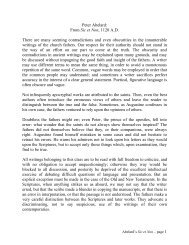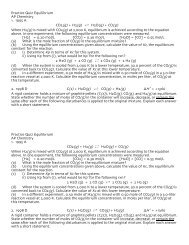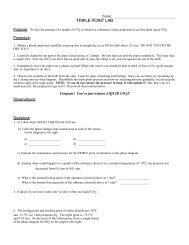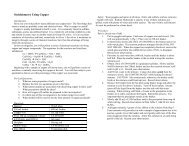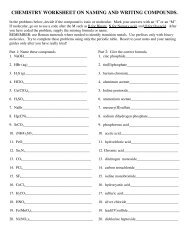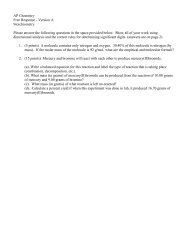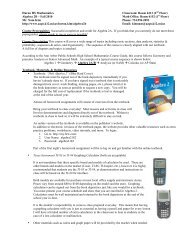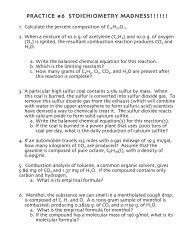Create successful ePaper yourself
Turn your PDF publications into a flip-book with our unique Google optimized e-Paper software.
Naming <strong>Organic</strong> Molecules<br />
Besides understanding the ester formation reaction, the naming of organic molecules is another<br />
important lesson. Naming organic molecules is actually rather involved. We are just going to<br />
touch on the basics. In short, it’s all about prefixes and fancy endings.<br />
The prefixes tell you how many carbons there are. The most common prefixes are in the<br />
table below.<br />
The endings tell you the type of organic chemical.<br />
We are just going to focus on 11 of the many types.<br />
1. Alkanes - Hydrocarbons (containing only C & H)<br />
that contain ONLY single bonds.<br />
-Name of alkanes always end in -ane.<br />
Ex: prefix + ane<br />
EX: Propane<br />
- Just a certain # of carbons (as specified by prefix) with H’s<br />
making all of the carbons “happy”! Remember, there can only<br />
be single bonds and carbon can only make four total bonds<br />
per carbon.<br />
1. “Prop-” means THREE CARBONS. Draw out your carbon<br />
chain...<br />
C -- C – C<br />
2. Knowing that carbon always wants to make FOUR bonds,<br />
make all of the carbons “happy” by filling in H’s.<br />
ORGANIC<br />
PREFIXES<br />
Meth-<br />
Eth-<br />
Prop-<br />
But-<br />
Pent-<br />
Hex -<br />
Hept-<br />
Oct -<br />
Non-<br />
Dec-<br />
= # of<br />
Carbons<br />
one<br />
two<br />
three<br />
four<br />
five<br />
six<br />
seven<br />
eight<br />
nine<br />
ten<br />
H H H<br />
l l l<br />
H–C – C – C–H =<br />
l l l<br />
H H H<br />
C3H8 or CH3CH2CH3<br />
3. Write the formula from your drawing.<br />
- If you don’t like drawing your alkanes out, their formula is represented by the<br />
following equation:<br />
C n H 2n+2<br />
- EX: methane CH4, ethane C2H6, propane C3H8<br />
2. Alkenes- Hydrocarbons that contains at least one double bond<br />
- Name of alkene always ends in -ene.<br />
Ex: prefix + ene<br />
- A certain # of carbons (as specified by prefix) with one double bond. The<br />
double bond could be between any two carbons in the molecule, but for our<br />
purposes - always put the double bond between the first two carbons.<br />
- You can draw the structure out or just know that the formula for an alkene is<br />
represented by C n H 2n
- EX: ethene or ethylene (same thing) = C2H4 H H<br />
⤷ \ /<br />
C = C<br />
-propene or propylene (same thing) = C3H6 / \<br />
H H<br />
H H ⤶ H H H<br />
\ l l l /<br />
C = C – C –H OR H–C – C = C<br />
/ l l l \<br />
H H H H H<br />
3. Alkynes- Hydrocarbons that contains at least one triple bond<br />
- Name of alkynes always end in -yne.<br />
Ex: prefix + yne<br />
- A certain # of carbons (as specified by prefix) with one triple bond. The triple bond<br />
could be between any two carbons in the chemical, but for our purposes, always put<br />
the triple bond between the first two carbons.<br />
- You can draw the structure out or just know that formula is represented by:<br />
C n H 2n-2<br />
EX: ethyne = C2H2<br />
⤷ H – C C – H<br />
H<br />
l<br />
H – C C – C – H propyne = C3H4<br />
l<br />
H<br />
FUNCTIONAL GROUPS:<br />
* 4. Alcohols- <strong>Organic</strong> compounds in which a hydrogen has been replaced with an -OH group.<br />
- General format: R -- OH, where R is a carbon chain.<br />
- Name of alcohols always ends in -anol.<br />
Ex: prefix + anol<br />
- To get the formulas, it is often very helpful to draw out the structure.<br />
EX: Butanol 1. “But-” means the alcohol comes from “butane” and has FOUR carbons.<br />
H H H H H H H H<br />
l l l l l l l l<br />
H –C – C – C – C– H 2. replace an “H” w/ OH group H– C – C – C – C – O – H<br />
l l l l l l l l<br />
H H H H H H H H<br />
“butane”<br />
“butanol”<br />
3. Write the formula from the picture. Butanol = C4H9OH or CH3CH2CH2CH2OH<br />
- EX: methanol = CH3OH, ethanol = C2H5OH, propanol = C3H5OH<br />
* 5. <strong>Organic</strong> Acids or Carboxylic acids O<br />
- <strong>Organic</strong> compounds that contains a carboxyl group....COOH. <br />
- General format R-COOH R – C – O – H
The “H” from the carboxyl group is actually acidic (meaning it can dissociate in water to make<br />
H+). However, all organic acids are WEAK acids. Names of organic acids always end in -anoic acid.<br />
EX: prefix + anoic acid<br />
However, many organic acids are more often named via common names that don’t follow this<br />
convention! Doh! To get the formulas, it is often helpful to draw out the structure<br />
EX: Ethanoic Acid 1. “Eth” means TWO carbons. C – C O<br />
<br />
2. One of the C’s will have a carbonyl group. C – C – O – H<br />
H O<br />
l <br />
3. Make all of the remaining C’s happy with H’s. H – C – C – O – H<br />
l<br />
H<br />
4. Write the formula. Ethanoic Acid (or ACETIC ACID) = CH3COOH<br />
** Please notice that the common name for ethanoic acid is acetic acid!!!<br />
- EX: methanoic acid (formic acid) = HCOOH, butanoic acid (butyric acid) = C3H7COOH<br />
O ⤶ H H H O ⤶<br />
l l l <br />
H – C – O – H<br />
H – C – C – C – C – O – H<br />
l l l<br />
H H H<br />
6. Esters: - For us, an ester is made when an alcohol and carboxylic acid react. You will see<br />
this in the introduction of the Ester’s Lab.<br />
O<br />
<br />
The general format of an ester is.....R – C – O – R’<br />
<br />
{from acid} {from alcohol}<br />
- Name esters by considering the acid and the alcohol that reacted to make the ester in<br />
question. Name the alcohol first - then the acid. For the alcohol, change the ending to -yl and for<br />
the acid, change the ending from “ic” to “ate.” This naming convention can be used on the systemic<br />
name or common name that is given to you for the acid or alcohol.<br />
EX:<br />
(alcohol)-yl (acid)-ate<br />
prefix<br />
prefix<br />
EX: propanol + ethanoic acid = propyl ethanoate (remember the common name for ethanoic acid is acetic acid)<br />
So it can also be . . .<br />
propanol + acetic acid = propyl acetate<br />
prefix<br />
prefi<br />
EX: methanol + butanoic acid = methyl butanoate (remember the common name for butanoic acid is butyric acid)<br />
So it can also be . . . methanol + butyric acid = methyl butyrate
The remaining functional groups are important to recognize but not so important to name....<br />
O<br />
7. Aldehydes: - An aldehyde contains a C=O (carbonyl group) connected to at least 1 hydrogen atom. <br />
R – C – H<br />
8. Ketones - A ketone is similar to an aldehyde in that it also contains a C=O (carbonyl group), O<br />
but in a ketone the carbon in the carbonyl group is not connected to any hydrogen atoms.<br />
<br />
R – C – R’<br />
9. Ethers - In an ether, an oxygen atom serves as a link in a hydrocarbon chain. R – O – R’<br />
10. Amines - In an amine, a hydrogen atom has been replaced by an amino group (NH2). R – NH2<br />
11. Halides - Halides are organic compounds in which one of more hydrogen have been R – X<br />
replaced with a halide (X = F, Cl, Br, or I)<br />
Ex: CH3Cl = chloromethane,<br />
CH3CH2Cl = chloroethane<br />
H ⤶ ⤷ H H<br />
l l l<br />
H – C – Cl<br />
H – C – C – Cl<br />
l l l<br />
H<br />
H H<br />
H<br />
NUMBERING COMPOUNDS /<br />
H H H H H O H H<br />
l l l l l l l l<br />
Ex : Consider the following two compounds, H– O – C – C – C -–C – H vs H – C – C – C – C – H<br />
l l l l l l l l<br />
H H H H H H H H<br />
Both compounds would be called butanol, but these compounds are different. In the first<br />
molecule, the OH is based off of the first carbon. In the second molecule, the OH is based off of the<br />
second carbon. How can we name these compounds in such a way that the location of the -OH<br />
group is somehow indicated? Follow the following steps...<br />
1. Determine the longest possible carbon chain in the molecule. This is the parent chain.<br />
2. Next, identify anything coming off the parent chain.<br />
3. Number the carbons in the parent chain so that the thing(s) coming off the chain can have<br />
the smallest possible numbers. As an example, butanol would be numbered....<br />
HO – CH2 – CH2 – CH2 – CH3<br />
↑ ↑ ↑ ↑<br />
1 2 3 4 . . . where the -OH is coming off the #1 carbon as opposed to<br />
numbering it like this . . . .<br />
CH3 – CH2 – CH2 – CH2 – OH<br />
↑ ↑ ↑ ↑<br />
1 2 3 4 ....where the -OH is coming off of the #4 carbon.<br />
4. The number that the extension is coming off of is incorporated into the name:<br />
OH<br />
l<br />
ex: CH3 – CH – CH2 – CH3 → 2-butanol ex: HO– CH2 – CH2 – CH2 – CH3 → 1-butanol<br />
↑ ↑ ↑ ↑<br />
1 2 3 4
CH3<br />
l<br />
ex: CH3 – CH – CH2 – CH3 → 2-methyl butane CH2CH3<br />
l<br />
ex: CH3 – CH2 – CH – CH2 – CH3 → 3-ethyl pentane<br />
ex: H – C CH – CH2 – CH2 – CH2 – CH3 → 1-hexyne<br />
ex: CH3 – C C – CH2 – CH2 – CH3 2 - hexyne<br />
ISOMERS: There are many times of isomers but for our case, we our only concerned with<br />
structural isomers. Structural isomers have the exact same formula, but different organization. The<br />
following three molecules are isomers:<br />
CH3<br />
l<br />
CH3 – CH2 – CH2 – CH2 – CH3 = pentane (C5H12)<br />
CH3 – C – CH3 = (C5H12)<br />
l 2,2-dimethylpropane<br />
CH3<br />
CH3<br />
l<br />
CH3 – CH – CH2 – CH3 = 2-methyl butane (C5H12)<br />
IN SUMMARY...<br />
TYPE FORMULA DESCRIPTION EXAMPLES<br />
CnH2n+2 - all single bonds, CH4 = methane,<br />
Alkane<br />
only C & H<br />
C2H6 = ethane<br />
CnH2n<br />
- at least 1 double bond C2H4 = ethene,<br />
Alkene<br />
C3H6 = propene<br />
CnH2n-2 1- at least triple bond C2H2 = ethyne,<br />
Alkyne<br />
C3H4 = propyne<br />
Alcohols<br />
R – OH - has a hydroxyl group CH3OH = methanol,<br />
C2H5OH = ethanol<br />
O<br />
O<br />
<br />
- has a carboxyl group <br />
(-COOH)<br />
R – C– OH<br />
CH3COH, ethanoic acid<br />
Esters<br />
O<br />
<br />
- an acid + an alcohol methyl ethanoate<br />
(methyl acetate)<br />
R – C – O – R’<br />
Aldehydes<br />
O<br />
O<br />
<br />
- ends in H<br />
<br />
R – C –H<br />
- has an carbonyl group<br />
CH3CH2CH, propanal<br />
Ketone<br />
O<br />
- has a carbonyl group- O<br />
<br />
- has an R group<br />
<br />
on both sides<br />
R – C – R’<br />
CH3CCH3, propanone<br />
<strong>Organic</strong> Acids<br />
(Carboxylic Acids)<br />
Ether R – O – R’<br />
-O sandwiched btwn<br />
two R’s<br />
Amine R – NH2 - has a -NH2 group<br />
Halide R – X X = F, Cl, Br, or I<br />
CH3–O–CH2CH3,<br />
methoxyethane<br />
CH3CH2CH2–NH2,<br />
propanamine<br />
H<br />
l<br />
H –C– Br<br />
l<br />
H
BREAK ASSIGNMENT: ORGANIC CHEMISTRY REVIEW QUESTIONS<br />
1. In a future lab you will synthesize aspirin from salicylic acid and acetic anhydride. This reaction<br />
does not go to completion (there are some leftover reactants mixed with the products). Do some<br />
research and describe the method that would be best used to separate your product from the excess<br />
reagents. Make sure to explain the chemistry behind this method.<br />
2. What do the following prefixes stand for?<br />
a. meth- ___________________________ b. hex- ___________________________<br />
c. prop- ___________________________ d. but- ___________________________<br />
3. a) Describe the differences between an aldehyde and a ketone.<br />
b) Describe the difference between an organic acid and a ester.<br />
c) Which do you think would be more soluble in water, an organic acid or an ester. Assume both<br />
molecules to have the same R groups. Explain your reasoning.<br />
d) Which do you think would be more soluble in water, an ether or an alcohol. Assume both<br />
molecules to have the same R groups. Explain your reasoning.
4. a) Identify the following compounds according to their functional groups. Your choices of<br />
answers are listed below.<br />
Alkane Alkene Alkyne Alcohol Aldehyde <strong>Organic</strong> acid<br />
Ester Ether Amine Halide Ketone<br />
b) Circle the part of the compound that is the functional group<br />
1. CH3CH2CH2CCH ______________________ 2. CH3CH2CH ___________________________<br />
O<br />
<br />
3. CH3CH2–NH2 ___________________________ 4. CH3CH2COH __________________________<br />
O<br />
<br />
5. CH3CH2–O–CH3 _________________________ 6. CH3CH=CHCH3 _______________________<br />
CH3<br />
CH3<br />
l<br />
l<br />
7. CH3–C–OH ______________________________ 8. CH3–C–CH2–CH3 ______________________<br />
l<br />
l<br />
CH3<br />
CH3<br />
5. Name the following compounds:<br />
OH<br />
l<br />
a. CH3CH2CH2CH2CH3 b. CH3CH2CHCH2CH3<br />
_________________________<br />
________________________<br />
O<br />
O<br />
<br />
<br />
c. CH3CH2–C–OH d. CH3CH2C–O–CH2CH3<br />
_________________________<br />
_________________________<br />
CH2CH3<br />
l<br />
e. CH3–CC–H f. CH3CHCH2CH2CH3<br />
_________________________<br />
__________________________<br />
CH3 CH2CH3 Cl<br />
\ / l<br />
g. C = C h. CH3CHCH2CH3<br />
/ \<br />
H H<br />
_________________________<br />
__________________________
i. CH3CH2CH2CH3 j. CH3CH2OH<br />
__________________________<br />
____________________________<br />
O<br />
<br />
k. CH3CH2CH2C–OH l. CH3Br<br />
__________________________<br />
_____________________________<br />
6. From the name, draw out the structure.<br />
a. cyclohexane b. 2,2-dimethylpentane<br />
c. 2-octanol d. pentanoic acid<br />
e. dichloromethane f. 2-butene<br />
g. ethyne (acetylene) h. propyl propanoate<br />
7. Draw as many structural isomers as you can for the following compound. CH3-CH2-O-CH2-CH3<br />
(Oh yes, you should also name them!)



